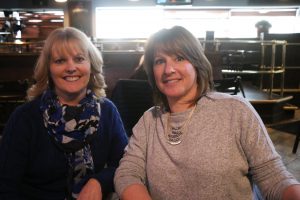Taking a Stand for Workplace Health & Safety

This article appeared in the Summer 2018 edition of the Union Stand
Heather Avery and Heather MacIvor knew something wasn’t right when their employer moved them into a relatively new office building in 2010. Within a few months, multiple coworkers became sick and had to be moved from the building. Avery and MacIvor both work for Nova Scotia Health Authority and provide Public Health, Mental Health, and Addiction Services to Pictou County residents. Ironically, they weren’t able to adequately provide those services as their own health was at risk due to a toxic work environment.
“There is a process that should have been followed with a new building,” says MacIvor. “The linoleum, the carpet, the new furniture, the paint… everything needs to be off-gassed. The process includes increa
sing the heat and the ventilation for a given time period. That was bypassed in a rush to finish things, of course we didn’t know that at the time.”
MacIvor recounts: “There were other things we didn’t know, and would only find out years later after pushing for independent contractors to investigate ongoing air quality issues. The floor wasn’t sealed properly and some of the air handling units were not actually hooked up. The building had previously been used as a racquetball club and there were walls within walls that cut off air circulation to sections of the building.”
The issue of who was responsible for the building and therefore who would cover the costs of remediation also delayed action and made things more complicated. Avery explains: “We lease space, so the Health Authority is responsible for anything that happens in the building itself. The owners are responsible for anything that goes on outside the building. So a recurring question was where do they end and where do we begin? We were caught in the middle.”
Avery and MacIvor describe the first two years as the most difficult time because they weren’t fully aware of the extent of their OHS rights. “During the first two years, we would bring members’ complaints to the Joint Occupational Health & Safety Committee (JOHS) and hope the Employer was following up with the owner of the building. This could take time. We would see maintenance people on the roof and would see them making adjustments and we were told to be patient and see if the adjustments worked,” says MacIvor.
“They would blame a lot of these things on the (changing) seasons,” she recalls. “There were all these reasons why we could be experiencing these symptoms. They seemed rational. They seemed reasonable. Much of the time we appeared unreasonable. But people were still not feeling well. We were going nowhere with internal remediation.”
Avery is a Chief Steward, has experience with the union, and sits on the JOHSC along with representatives from management, CUPE and NSNU. “We have really good people on the JOHSC and work within our mandate to represent the OHS concerns of the membership,” she says.
“After the two years, people were feeling worse and not knowing what to do,” says MacIvor. “We had a lot of respiratory symptoms in our department. People would lose their voice. They would have burning, red, and sore eyes – not just dry. They had facial flushing, and unusual headaches. People weren’t really speaking up – they didn’t want to complain.”
With the help and support received from the NSGEU OHS Officer Paul Cormier, and Employee Relations Officer Donnie MacNeil, as well as an OHS Officer from the Department of Labour and Pictou County Health Authority OHS consultant were able to convince the Employer to bring in an independent consultant to assess the building. “He went through the building and there were adjustments made and some things were found. Some things started to improve,” says MacIvor.
However, as time went on people grew sicker and started missing more time at work. “It was primarily respiratory,” says MacIvor. “People were feeling faint and foggy, as though they were going to pass out. The flushing feeling and feelings of light headedness continued.”
“We kept looking for a smoking gun… but it was not there,” adds Avery.
“When we called the Department of Labour for the second time, we were very fortunate that we had the same officer,” recalls MacIvor. “She knew the history and knew where to pick up. She met with us and facilitated us working together. She was really great. I attribute a lot to her.”
Still, the symptoms continued for many.
“It started to scare people,” says MacIvor. “People were breaking out in rashes before your eyes – it was very concerning. You felt so bad for someone else. You might not feel that for yourself. But when you are looking at a colleague you sit beside every day and you have to tell them ‘you are not looking well, what is happening to you’ and they are having these terrible things happen to them – you want to fight for them.”
Following instructions was absolutely necessary throughout the process. “When you have bad air quality – it can be like an invisible monster,” explains MacIvor. “The Department of Labour’s OHS Officer told us we had to work through a process of elimination. So we started with the simplest of things. We took plants out of the building, fans, cardboard boxes, old tape. Anything that could carry mold.”
Avery and MacIvor continued to attend JOHSC meetings and bring documentation forward pushing for answers, which couldn’t be ignored. This was stressful. As advocates, they felt badly about having to continually repeat themselves and push management for action.
“During this time, we were so grateful for the support we were offered from our NSGEU ERO Donnie MacNeil, and our OHS Officer Paul Cormier,” says Avery. “I think if it wasn’t for them, we would never have left the building.”
MacNeil and Cormier also organized a meeting of employees from other unions working in the building to discuss their symptoms. Avery recalls, “It was clear that the building didn’t discriminate. Anyone who worked in the building felt the effects of the bad air quality – even patients.”
During this time Avery and MacIvor came to know and trust each other for support and guidance. “There are those tense times you need to know who you can trust and Avery is one of those people,” says MacIvor. “She’s enthusiastic, energetic and will take anything on. She’s a champion.”
Avery has strong and inspiring words about MacIvor as well. “I have never met anyone who was so determined,” she says. “She would say to me, ‘Honestly, this is not going away. We are not going to let it go away. Nothing is going to be swept under the rug anymore. We are taking a stand and going to go with this…we do have the right to know this.’
In 2015, members working in Public Health presented their symptoms at the JOHSC and asked to be accommodated at another location. “Over 80% of the employees were having severe symptoms,” says MacIvor. “We took this information to the JOHSC along with graphs and charts and the committee voted that we should leave until there is a resolution and investigation into that area of the building.”
The members working in Mental Health and Addictions handled their OHS concerns a little differently. Beginning in 2016, members filed individual work refusals or went to the doctor and got accommodated through their managers and the OHS department or the OH nurse. “It wasn’t like a walkout – it happened over months and months,” says Avery. “Some casuals took longer to leave, but in the end, all of our NSGEU members left. Our team was accommodated and moved temporarily to Pictou.”
Employees working in the Public Health area were away from the building for two and a half years, and the vast majority of the Mental Health and Addictions staff were off site for approximately 16 months.
Once the majority of people were out of the building, and the owner took responsibility and remediation was relatively quick. “Apparently now everything has been done properly with the flooring so that all the moisture and water will not come to the surface – there is a complete barrier now,” says Avery.
As of December 2017, both groups of workers had been returned to the building. Unfortunately, working in a contaminated building can make you extremely sensitive to air problems and there are still people reporting symptoms. “Once you have worked in an environment for so long, you are like a canary,” says Avery.
”You can’t make something brand new again,” adds MacIvor. “People who have developed allergies and sensitivities will have those for their whole life. The issues with the building are ongoing.”
The JOHSC meetings now are focused on tests and results and concrete action. “At our September JOHSC meeting, we sat down to determine what we wanted to see happen to the building. We weren’t just going to take anyone’s word for it,” MacIvor explains.
Both Avery and MacIvor feel the current management is focused on OHS and proactive and supportive.
The lessons are strong and clear according to Avery: “As far as what others should do who find themselves in this situation? Document your symptoms. If your department has a process in place to report symptoms ensure the proper reports are filled out. Bring in the Department of Labour for guidance. Contact your union and set up a meeting with your representative and your OHS representative.”
“I think the hardest part, probably, was people standing up for themselves and feeling like they were going to be protected,” says MacIvor. “When you make that decision and you think something is wrong, you have to stand up.”
We really needed the support of ERO Donnie MacNeil, our OHS Officer Paul Cormier, and our Department of Labour OHS Officer,” says Avery.
Unfortunately, OHS issues with this building may never be permanently resolved. If there continues to be symptoms reported, investigations will need to be done, again and again.
Everyone has the right to work in an environment that is not harmful to their health. Avery and MacIvor want other members to know that standing up for workplace health is important.
“Even though people are still going to have the cynical outlook every now and then, the tides have changed and there are more people on our side who believe change is possible. We really did improve things.”
